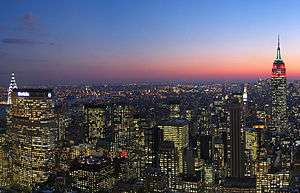Guyanese Americans
| Total population | |
|---|---|
| (208,899 (±11,894)[1]) | |
| Regions with significant populations | |
| New York · New Jersey · Maryland · Florida · California · Texas · Pennsylvania | |
| Languages | |
| American English · Guyanese Creole | |
| Religion | |
| Christianity · Hinduism · Islam · Obeah |
Guyanese Americans are Americans who can trace their ancestry back to Guyana.
History
After the independence of Guyana from Great Britain, in 1966, Guyanese immigration to the United States increased dramatically. Political and economic uncertainty, and the internal strife two years earlier as well as a radical change in US immigration policy opening up opportunities to non-Europeans prompted many Guyanese who could make the move to seek opportunities abroad.
Many of the first Guyanese immigrants to the United States were of African descent. They were women who were recruited as domestic workers or nursing assistants. Prior to the Immigration and Nationality Act of 1952 Guyanese of Asian descent faced immigration restrictions because of existence of Asiatic Barred Zone. However, many Guyanese who had studied in the US in the mid 20th century or earlier stayed on in the US; some, like Cheddi Jagan returned to Guyana. Shirley Chisholm's father represents one of the earliest of Guyanese immigrants to the US during the 20th century; emigration from Guyana at that time was mostly to Caribbean or Commonwealth countries.[2]
Demographics

The United States has the highest number of Guyanese people outside of Guyana. The Guyanese-American community consists basically of people of Afro-Guyanese and Indo-Guyanese origins.[4]
As of 1990, 80 percent of Guyanese Americans lived in the Northeast. A large concentration of them can be found in the neighborhoods of Richmond Hill, Queens,[2] Irvington, New Jersey, Orange, New Jersey, East Orange, New Jersey, Flatbush, Brooklyn, East Flatbush, Brooklyn, Rockland County, New York, and Schenectady, New York.[2]
The Guyanese Americans students vary their English accent, depending on whether they are at home or at school. In schools, Guyanese students learn to speak The British English. Some Indo–Guyanese Americans, in addition to speaking English, also speak Hindi. The Indians have religious ceremonies at their houses monthly and they attend a temple. The Indo-Guyanese who are Christian attend a local church but there are a lot more Hindus than Christians. They have various centers for Bhajans.[4]
Business
The Guyanese have formed their own businesses in the United States; many of which are shops, restaurants of traditional Guyanese cuisine, grocery stores, and jewelry stores. There are also many shops of clothing belonging to Guyanese that sell clothing Indian (due to the many Guyanese of Indian origin). In addition to these stores, there are also video playback stores specializing in Bollywood films with English subtitles for those who do not understand Hindi. The Indo - Guyanese Americans try to keep alive their culture and contact with Guyana and India. Hence, they watch movies, listen to music and read books of Guyana and India. In addition, people of Indian - Guyanese descent that do not speak Hindi, try to learn it from their nearby Hindu temples, generally conducted by Guyanese Hindu Brahmin Pandits.[4]
Politics
Guyanese have organized most of the U.S. Caribbean organizations. There are many nurses from Guyana and police associations. Although this group has not managed to have a collective impact on U.S. national policy, they have organized, however, through their churches with other ethnic groups to promote knowledge and struggles against the problems in their neighborhoods. Have also entered local politics.[2]
Shirley Chisholm was the only Congresswoman of Guyanese descent in American history, as well as the first African-American woman elected to the United States Congress.
Associations
Some of the associations are the Indo-Caribbean American Cultural and Arts Association, The Indo-Caribbean Federation of North America, and the Association of Guyanese-Americans. A major part of the shows the various Indo-Guyanese Associations put together his the songs and dances.The Indo-Guyanese organizations teach the youth about their cultural origins and let them show it off on stage by performing dances, songs, and plays. The development of the cultural groups in the area had made a necessity for announcements of community news.[4]
Relations with Guyana
The Guyanese American community has close ties with Guyana and help them financially to this country. There is a large ongoing academic exchanges between Guyana and the United States as academic conferences.[2] The Journal of the Caribbean is a Caribbean newspaper important to inform the Indo-Guyanese and other Caribbean groups of their achievements and inform them about the events in Guyana. This newspaper is published weekly and distributed throughout North America. The publications of these papers are written in English. However, there are also publications in other languages. Newspapers offer services to help people. In the newspaper there is tax air tickets and visa forms, applications and service support for the elderly, advertisements for charities for children in Guyana and India.[4]
List of famous Guyanese Americans
- Godfrey Cambridge
- Shirley Chisholm
- Darren Collison
- Rafael Cameron
- Adrian Drepaul
- Kevin Darlington
- Oscar Dathorne
- Adrian Dutchin
- Rhona Fox
- Mel King
- Dawnn Lewis
- Derek Luke (Guyanese father)
- Steve Massiah
- Nicole Narain
- C. C. H. Pounder
- Thara Prashad
- Rihanna (Guyanese mother)
- Arman Shields
- Alana Shipp
- Mark Teixeira
- Sean Patrick Thomas
References
- ↑ Table B04006, People Reporting Ancestry, 2011 American Community Survey 1-Year Estimates, United States Census Bureau
- 1 2 3 4 5 Countries and Their Cultures-Guyanese American. Posted by Jacqueline A. McLeod. Retrieved June 10, 2011.
- ↑ "Yearbook of Immigration Statistics: 2011 Supplemental Table 2". U.S. Department of Homeland Security. Retrieved 2012-07-08.
- 1 2 3 4 5 Voices of new York. Posted by Brenda Mangru and Madhu Pillai. Retrieved June 25, 2011